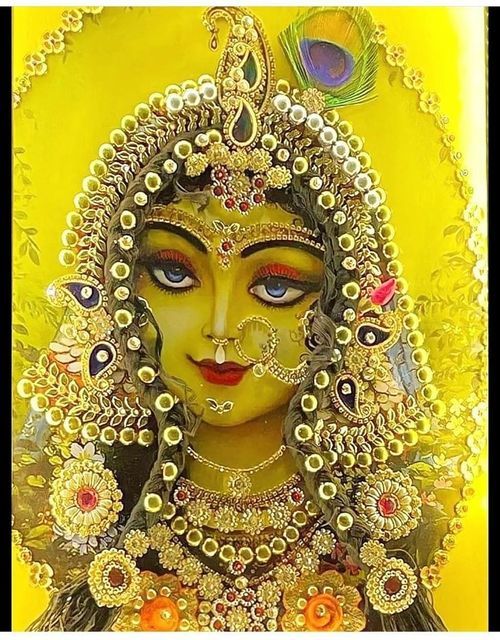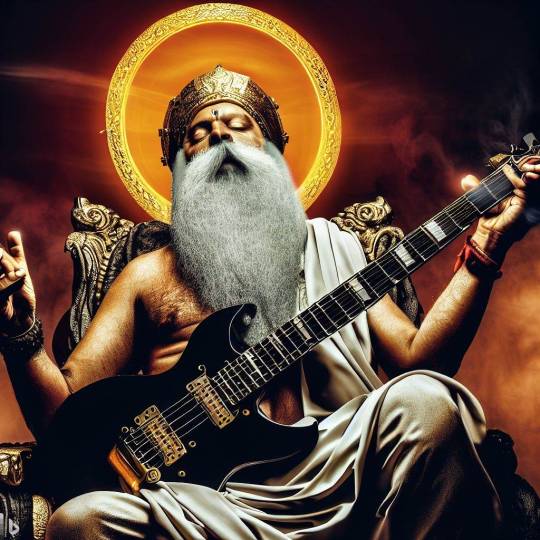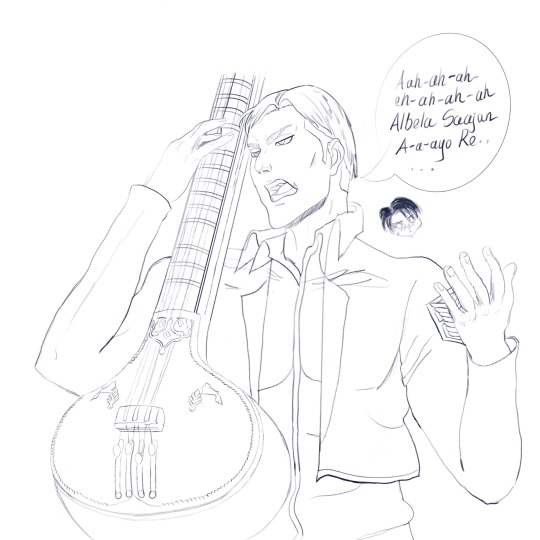#Indian Raga
Video
youtube
Divine Sitar | Royal Raag Shahana | Anupama Bhagwat | Music of India

Morning Sitar Meditation Music 🙏🕉️🪷🌞🩶
Divine Sitar | Royal Raag Shahana | Anupama Bhagwat | Music of India
6 notes
·
View notes
Text
Shoegazer guitar
2 notes
·
View notes
Text

𝗕𝗟𝗢𝗚 𝟱 || 𝗖𝗼𝗻𝗻𝗲𝗰𝘁𝗶𝗼𝗻 𝗯𝗲𝘁𝘄𝗲𝗲𝗻 𝗔𝗻𝗰𝗶𝗲𝗻𝘁 𝗠𝗮𝗻𝘁𝗿𝗮𝘀 𝗮𝗻𝗱 𝗠𝘂𝘀𝗶𝗰 || 𝗦𝗼𝘂𝗻𝗱 𝗼𝗳 𝗦𝗼𝗺
Ancient mantras and music have a deep relationship that can be explored from various perspectives. Mantras are sacred sounds or phrases traditionally used in religious or spiritual practices, while music is a form of artistic expression that utilizes sound and rhythm. The connection between ancient mantras and music can be understood in multiple ways:
1. Sacred Sound: In various ancient traditions, including Hinduism and Buddhism, mantras are believed to carry spiritual power and vibrations that can create a positive impact on individuals and the environment. Similarly, music is often considered a powerful medium that can evoke emotions, uplift the spirit, and create a sacred atmosphere. Both mantras and music rely on the power of sound to influence people's inner state and create a spiritual connection.
2. Devotional Practices: Mantras are often chanted or repeated as part of devotional practices to invoke divine energy or connect with a higher power. Similarly, music has been used in religious and spiritual ceremonies, rituals, and gatherings to enhance the worship experience and facilitate a deeper connection with the divine. The combination of ancient mantras and music can create a profound spiritual ambiance, allowing individuals to experience a sense of transcendence and inner peace.
3. Healing and Therapy: Ancient mantras are believed to have healing properties and are used in various forms of sound therapy. The rhythmic repetition of mantras is believed to have a calming effect on the mind and can be used for relaxation, stress reduction, and promoting overall well-being. Music therapy, on the other hand, utilizes the therapeutic effects of music to address physical, emotional, and mental health concerns. The combination of ancient mantras and music can enhance the healing potential and provide a holistic approach to well-being.
4. Cultural and Historical Significance: Mantras and music have played significant roles in ancient cultures and civilizations throughout history. The chanting of mantras has been an integral part of religious and spiritual practices, while music has been used for storytelling, cultural expression, and community gatherings. Both mantras and music carry the essence of cultural heritage and can serve as a bridge between ancient traditions and contemporary practices.
In summary, the deep relation between ancient mantras and music exists due to their shared use of sound, their ability to invoke spiritual connection, their potential for healing and therapeutic benefits, and their cultural and historical significance. Together, they create a rich tapestry of spiritual and artistic expression.
#soundofsom #musicblog #indianmusic #mantras
#soundofsom#music#instrumental#ambient music#somak sinha#experimental music#ancient india#mantra#indian raga#indian music
0 notes
Text
Shakti Style Backing Tracks: Guitar Tabla Easy Chords:
Shakti Backing Tracks as Requested.
CLICK SUBSCRIBE!
Hi Guys, here are a few simple Shakti style backing tracks catalogued on one page as requested:
BACKING TRACK 1:
Lotus Feet Shakti John McLaughlin Backing Track
“Lotus Feet” Guitar Melody to play over Backing Track:
BACKING TRACK 2:
Shakti John McLaughlin Style Backing Track for Face to Face Style
BACKING TRACK 3:
Shakti Style Backing Track Loop/simple chords
The two…

View On WordPress
#backing track#backing tracks#face to face#Indian raga#jam tracks#John McLaughlin jam tracks#music#shakti#Shakti Backing Tracks#shakti lotus feet
0 notes
Video
youtube
Unleashing the Magic of RAAGA in a Mesmerizing SOLO Performance | Guess ...
#youtube#raaga#raaga music#indian classical music#gues the raaga#raga music#indian raga#indian music
1 note
·
View note
Text

Unknown, Bhairava Raga, Pahari, Nurpur, c.1690. Courtesy of the Claudio Moscatelli Collection and Matthew Hollow Photography and via
140 notes
·
View notes
Text
Raga Salang - Madhya Lay Gat In Jhap Taal
youtube
❤️ 🎶
2 notes
·
View notes
Text
make love all day long
make love singing songs
my heart dances with the tabla taal. Alaap notes of the Raga laughing in the fresh morning air. feet subconsciously springing into practiced action of the Kathak routine. eyes closed, shoulders moving on beat, eyebrows with their bold expressions, wrists twirling in mudras, the echoes of ghungoor jingles drift by as if in a dream.
Dhrupad takes me by storm. A kurti clad Cinderella with her musical prince, dancing endlessly in the empty courtroom, high on the essence of freedom and self-expression, remembered.
The sitar strings with the Jhala approach, their beats picking up, the time is precious, pure and revered. my heart and body's rhythm is one with it's eager spirits.
I laugh in delirium. 2:58. And it plays again.
I could listen to the song all day long. It's a love letter addressed to all the Indian classical music souls, a much needed embrace of reminders, assurances, and forgotten lovers.
#love you to#the beatles#ravi shankar#indian classical music#raga rock#kathak#desi tumblr#a tribute#ash writes#Spotify
17 notes
·
View notes
Text
Ghazals and ragas>>>>>>>
#desiblr#desi#being desi#desi tumblr#desi humor#desi things#ghazals#ragas#indian music#desi dark academia#desi academia#dark academia#india dark academia#i love ghazals and ragas like i could never be bored listening to them
4 notes
·
View notes
Text
udayaravichandrika is a such a good example of an oxymoron! (udayaravichandrika is a carnatic raga btw). like udayaravi means rising sun while chandrika means moonlight
11 notes
·
View notes
Video
youtube
Raga Brindavani Sarang


Raga Brindavani Sarang · Sanjay Deshpande
https://youtu.be/gRo4k7aA0TI?si=S9RA2fSRTILympdc via @YouTube
#youtube#sitar#sitar music#indian music#indian raga#world music#meditation music#India#Krishna#Radhe#Radhey Radhey#Radha Krishna#Darshan#Hare Krishna#Vrindavan
16 notes
·
View notes
Text

𝗕𝗟𝗢𝗚 𝟯 || 𝗖𝗼𝗻𝗻𝗲𝗰𝘁𝗶𝗼𝗻 𝗯𝗲𝘁𝘄𝗲𝗲𝗻 𝗩𝗲𝗱𝗮𝘀, 𝗼𝗹𝗱𝗲𝘀𝘁 𝗵𝗶𝗻𝗱𝘂 𝘀𝗰𝗶𝗽𝘁𝘂𝗿𝗲𝘀 𝗮𝗻𝗱 𝗜𝗻𝗱𝗶𝗮𝗻 𝗥𝗮𝗴𝗮𝘀|| 𝗦𝗼𝘂𝗻𝗱 𝗼𝗳 𝗦𝗼𝗺
The Vedas, India's oldest Hindu scriptures, and Indian classical music are inseparable from one another. The Vedas are a collection of hymns, mantras, and spiritual texts that were written over 3,500 years ago in Sanskrit. Indian classical music, meanwhile, has roots tracing back to ancient India. These two pieces of India's cultural heritage have a deep, historical relationship.
The Vedas provide a blueprint for Indian classical music, establishing the foundation by delineating the swaras (notes), the ragas (scales), and the talas (rhythmic patterns). Indian classical music is believed to be based on the Sama Veda, one of the four Vedas, which refers to the religious chanting that was originally used in Hindu religious rituals.
Furthermore, Indian ragas are also linked to certain times of day, seasons, and emotions. This link between the Vedas and Indian classical music is seen to this day, as Indian classical music has evolved to reflect modern tastes while still staying true to its roots.
The Vedas classify sound into 22 shrutis, or microtones, which represent the smallest differences in pitch that the human ear can detect. These shrutis form the building blocks for Indian classical music. The Indian classical music system identifies seven primary swaras: Sa, Re, Ga, Ma, Pa, Dha, and Ni. From these swaras, numerous ragas and talas have been formed, forming the rich and diverse tradition of Indian classical music.
The connection between the Vedas and Indian classical music is vital to the preservation of Indian culture. Through music, the Vedas have maintained their relevance to contemporary society, providing a living example of how ancient religious texts can remain vibrant and meaningful amidst changing times. Indian classical music serves as a beautiful reminder of India's rich cultural and spiritual heritage, and its connection to the Vedas gives it a unique strength and history.
In conclusion, the early Hindu scriptures, particularly the Vedas, have contributed to the creation and development of Indian classical music. They have not only given a blueprint for the musical notation system but have also played a significant role in shaping the musical aesthetics. Indian classical music has evolved and adapted over the centuries, but its roots in the ancient Vedas remain a vital and integral part of Indian culture.
#indianmusic #classicalmusic #soundofsom #somaksinha
0 notes
Text
Shakti: Indian Raga alternate picking and fretting hand technique[Development]
CLICK SUBSCRIBE!
Please watch video above for detailed info:
Hi Guys,
Today, a quick look at developing Shakti style Fusion guitar Raga’s from the Mixolydian mode.
Below, is the mode in a Pentatonic form:
Next, we have a phrase that is developed from this mode. In order for it to be smooth and fluid at a “Fast” tempo we will change the fingering:
So, here the 2nd finger comes into play.…

View On WordPress
#alternate picking#face to face#guitar raga&039;s#guitar technique#how to#indian guitar lesson#Indian raga#jaap taal#John Mclaughlin#lesson#natural elements#raga guitar#raga guitar method#shakti#teen taal
0 notes
Text

Erwin Smith’s New Morning Routine
To exercise his charming, commanding voice
#attack on titan#commander erwin#erwin smith#sitar player#captain levi#hange zoe#aot fandom#indian music#saregama#morning raga
6 notes
·
View notes
Text
#classical music#indian classical dance#indian classical music#music inspiration#music#bhairav raga#raga
0 notes
Text
Pan-Asian Metropolis -- Indian Los Angeles

View On WordPress
#Asian America#Bollywood#Hinduism#Indian Americans#Indian Angelenos#Indian Los Angeles#Little India#Los Angeles#No Enclave#Pan-Asian Metropolis#Raga Rock#Religion#Subculture#Vegetarianism
0 notes